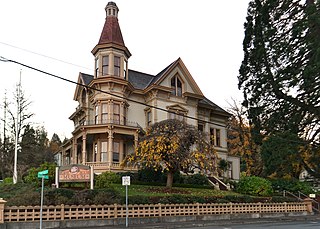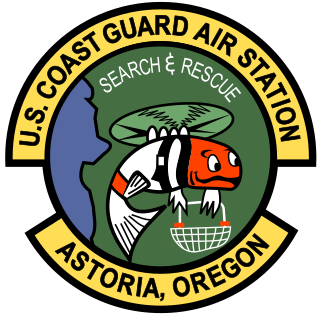
Astoria is a port city and the seat of Clatsop County, Oregon, United States. Founded in 1811, Astoria is the oldest city in the state of Oregon and was the first American settlement west of the Rocky Mountains. The county is the northwest corner of Oregon, and Astoria is located on the south shore of the Columbia River, where the river flows into the Pacific Ocean. The city is named for John Jacob Astor, an investor and entrepreneur from New York City, whose American Fur Company founded Fort Astoria at the site and established a monopoly in the fur trade in the early nineteenth century. Astoria was incorporated by the Oregon Legislative Assembly on October 20, 1876.

Pacific County is a county in the U.S. state of Washington. As of the 2020 census, the population was 23,365. Its county seat is South Bend, and its largest city is Raymond. The county was formed by the government of Oregon Territory in February 1851 and is named for the Pacific Ocean.

Lincoln County is one of the 36 counties in the U.S. state of Oregon. As of the 2020 census, its population was 50,395. The county seat is Newport. The county is named for Abraham Lincoln, 16th president of the United States.

Clatsop County is one of the 36 counties in the U.S. state of Oregon. As of the 2020 census, the population was 41,072. The county seat is Astoria. The county is named for the Clatsop tribe of Native Americans, who lived along the coast of the Pacific Ocean prior to European settlement.

Astoria is a neighborhood in the western portion of the New York City borough of Queens. Astoria is bounded by the East River and is adjacent to three other Queens neighborhoods: Long Island City to the southwest, Sunnyside to the southeast, and Woodside to the east. As of 2019, Astoria has an estimated population of 95,446.
The Wallooskee River is a tributary of the Youngs River, about 10 miles (16 km) long, in northwest Oregon in the United States. It drains a small area of the foothills of the Coast Range near the mouth of the Columbia River. The Youngs River is a tributary of the Columbia River.

The Astoria–Megler Bridge is a steel cantilever through truss bridge in the northwest United States that spans the lower Columbia River, between Astoria, Oregon, and Point Ellice near Megler, Washington. Opened in 1966, it is the longest continuous truss bridge in North America.

In the U.S. state of Oregon, U.S. Route 30, a major east–west U.S. Highway, runs from its western terminus in Astoria to the Idaho border east of Ontario. West of Portland, US 30 generally follows the southern shore of the Columbia River; east of Portland the highway has largely been replaced with Interstate 84, though it is signed all the way across the state, and diverges from the I-84 mainline in several towns, as a de facto business route. Out of all the states U.S. Route 30 traverses, it spends the most time in Oregon. At 477 miles, it is also the longest road in the state.

The Captain George Flavel House Museum known also as Capt. George Flavel House and Carriage House or the Flavel Mansion, is now a house museum in Astoria, Oregon, United States. It was built in 1885 in the Queen Anne architectural style, by George Flavel, a Columbia River bar pilot who was one of the area's first millionaires.

Wide West was a steamboat that served in the Pacific Northwest of the United States. It had a reputation as a luxury boat of its days.

Coast Guard Air Station Astoria was established August 14, 1964 at Astoria Regional Airport in Warrenton, Oregon, United States.
Megler is a small unincorporated community in Pacific County in the U.S. state of Washington. Named for legislator Joseph G. Megler, the community is at the mouth of the Columbia River on the north shore of the river. It is the northern end of the Astoria-Megler Bridge, which connects Megler to Astoria, Oregon, a nearby city on the south shore of the river. U.S. Route 101 and State Route 401 intersect in the community and connect Megler to Aberdeen, Olympia, and Vancouver.

Olney is an unincorporated community and former company town in Clatsop County, Oregon, United States, on Oregon Route 202 approximately eight miles south of Astoria. Olney is located at 46.100109°N 123.757637°W. Its post office is assigned ZIP code 97325.

The Astoria Riverfront Trolley is a 3-mile (4.8 km) heritage streetcar line that operates in Astoria, Oregon, United States, using former freight railroad tracks along or near the south bank of the Columbia River, with no overhead line. The service began operating in 1999, using a 1913-built streetcar from San Antonio, Texas. As of 2012, the service was reported as carrying 35,000 to 40,000 passengers per year and has been called a "symbol" and "icon" of Astoria. The line's operation is seasonal, normally during spring break and from May through September.
The Marshall J. Kinney Cannery, located in Uniontown, Astoria, Oregon, United States, between Fifth and Seventh streets, was constructed in 1879 and became one of the city's longest-running salmon canneries. Run by the Astoria Packing Company, of which Marshall J. Kinney was president, the complex quickly became the "largest and most extensive salmon-packing establishment on the Pacific Coast". In 1894, the cannery was completely rebuilt after being burned to the ground. Five years later Kinney became part of the Columbia River Packers Association, joining several other canneries and packing companies. By 1904, the complex supported three production lines; Kinney continued cannery operations until the 1920s when it was primarily used as a central machine shop and warehouse for the Columbia River Packers Association. In 1954, a cargo ship ran into the complex, part of which was lost. Intact portions were used for storage until 1980 and today house shops and small businesses. The cannery was added to the National Register of Historic Places on June 30, 1989, but was delisted on September 8, 1997.

Forest Grove Fire and Rescue is the municipal fire department for the city of Forest Grove, Oregon. Started in 1894, the department has two stations used to provide fire fighting and emergency medical services to both the city and the Forest Grove Rural Fire Protection District. The department also provides administrative support to the neighboring Cornelius Fire Department.

Harvest Queen was the name of two stern-wheel steamboat built and operated in Oregon. Both vessels were well known in their day and had reputations for speed, power, and efficiency.The first Harvest Queen, widely considered one of the finest steamers of its day, was constructed at Celilo, Oregon, which was then separated from the other portions of the navigable Columbia River by two stretches of difficult to pass rapids.

Telephone was a sternwheel-driven steamboat built in 1884 by Captain Uriah Bonsor "U.B." Scott for service on the Columbia River. Reputedly the fastest steamboat in the world in its time, Telephone served on the Columbia River and San Francisco Bay. Telephone was rebuilt at least twice. The first time was after a fire in 1887 which nearly destroyed the vessel. The reconstructed and much larger second vessel was sometimes referred to as Telephone No. 2. The third vessel, Telephone No. 3, built in 1903 and using components from the second steamer was larger but little used during its time on the Columbia river.

Telegraph was a sternwheel-driven steamboat built in 1903 in Everett, Washington. Except for the summer of 1905, from 1903 to 1912, Telegraph served in Puget Sound, running mainly on the route from Seattle to Everett, and also from Seattle to Tacoma and Olympia, Washington.

The Callendar Navigation Company, sometimes seen as the Callendar Transportation Company, started in business in the early 1900s. Callendar was formed in the early 1900s, and was based in Astoria, Oregon. Callender was to become one of six large towing companies of the Columbia and Willamette rivers in the early decades of the 1900s, the others being Shaver Transportation, Smith Transportation, Hosford, Knappton Towing Co., and Willamette and Columbia River Towing Co. In 1922, Callendar Navigation merged with Knappton Towboat Co., which existed, with a name change in 1990, and which became part of Foss Marine in 1993.



















